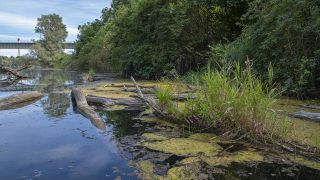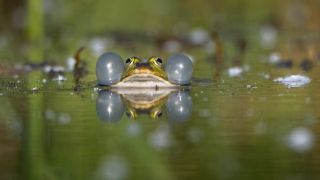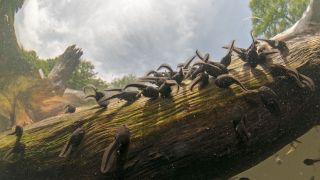Revitalization of bays along the Danube creates new habitats for fish and amphibians
Bays along a 3.3-kilometre stretch of riverbank on the Danube Island were dredged to create new habitats for fish and amphibians.
Dredging was going on from mid-January to mid-March 2022 in bays and side arms along a 3.3-kilometre stretch of riverbank on the Danube Island. These new deeper sections serve as habitat and spawning grounds for fish and amphibians.
A recent monitoring exercise carried out by scientists from Vienna University of Natural Resources and Life Sciences (BOKU) showed that these habitats are especially biodiverse: 38 species of fish, over 60 species of macrophytes and numerous dragonfly species have been recorded there.
The measure is part of the EU LIFE DICCA project run by Municipal Department 45 - Water Management (MA 45).
Hot, dry conditions are having a detrimental effect on habitats
Near-natural stretches of riverbank and side arms with bays, peninsulas and shallows extend over several kilometres on the Danube side of the Danube Island, from Reichsbrücke bridge down to the area around the Freudenau hydroelectric plant.
These riverbank zones were deliberately created as a habitat for animals and plants when the Danube Island was constructed and later on during the building of the Freudenau hydroelectric plant in the 1990s.
In the past few decades, however, silting up and drying out of ponds has placed these vital fish and amphibian habitats at risk. Over the years, periods of extremely high water have brought in quantities of sediment that have gradually caused these bays and side arms to silt up.
The problem is being exacerbated by climate change and the more frequent flooding of the River Danube that is expected as a result. Dry conditions and prolonged heatwaves are likewise causing these bays along the riverbank to dry out.
This is how the works were carried out
- Suction dredgers and floating mechanical dredgers were carrying out the works at a total of 15 sites.
- Affected sections of riverbank: For structural engineering reasons the works were being carried out section by section, and sometimes in parallel.
- Section A: across the island from the rowing centre, near Steinsporn Bridge
- Section B: beside the Danube Island wind turbine, near Steinsporn Bridge
- Section C: across the island from the Wehr 1 barrage
- Section D: close to Kaisermühlen Bridge
- Section E: bay beside Reichsbrücke bridge.
- Section F: between Reichsbrücke bridge and Brigittenau Bridge
- The fine sediments, i.e. silt and mud, excavated by the dredgers and pumped via pipes into the Danube. A total of approx. 20,000 cubic metres of fine sediment were moved into the river.
- The dredging works were being carried out under the supervision of ARGE Ökologie, a firm of specialist environmental engineers.
City of Vienna | Water Management
Any questions, requests, or concerns? Please contact the City Service at contact form





